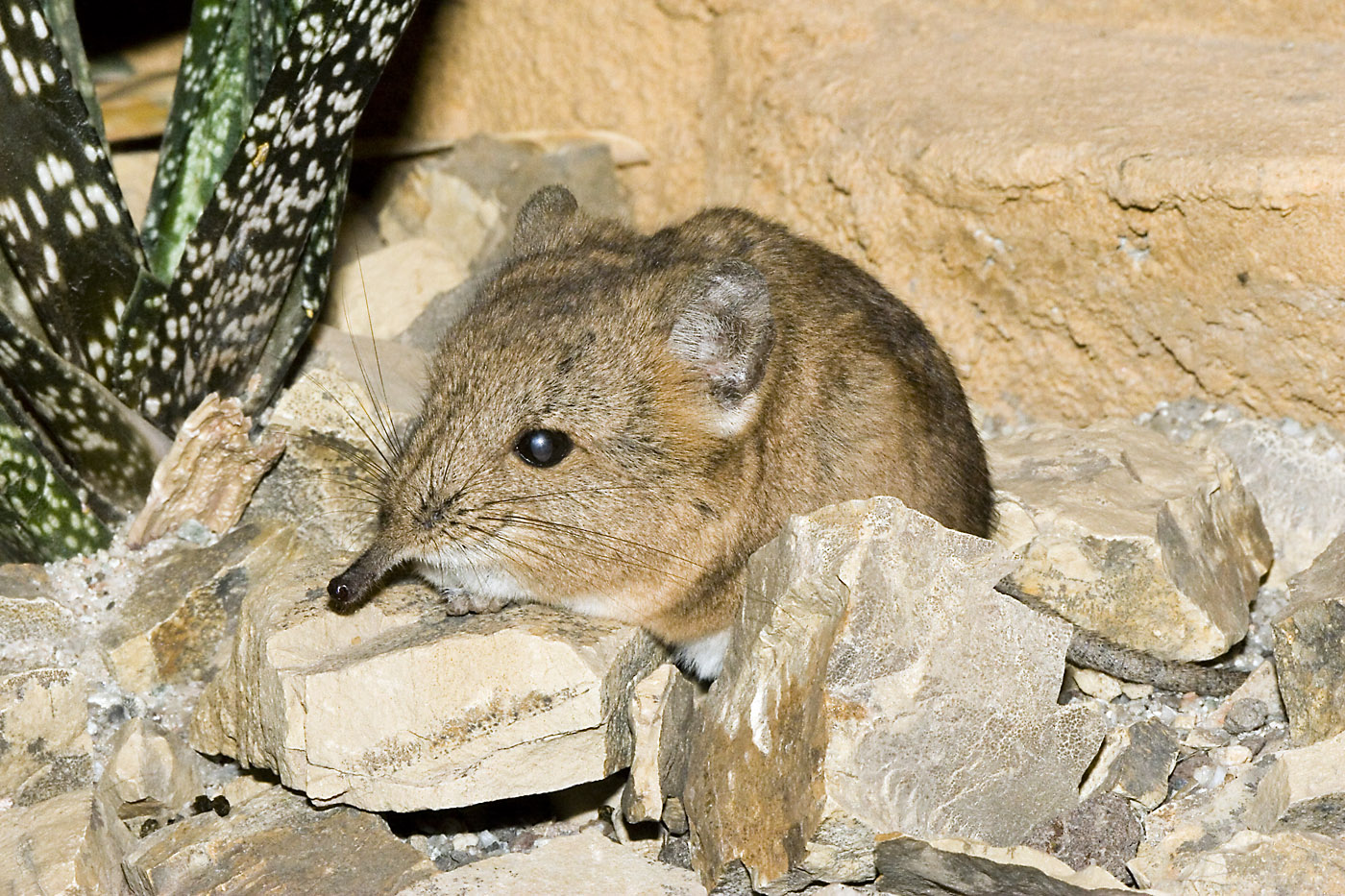- Elephant shrew
Taxobox
name = Elephant shrewsMSW3 Schlitter|pages=82-85]
fossil_range = EarlyOligocene to Recentcite book |author= Savage, RJG, & Long, MR|year=1986 |title= Mammal Evolution: an illustrated guide|publisher= Facts on File|location=New York|pages= 54|isbn= 0-8160-1194-X]

image_width = 200px
image_caption =Short-eared Elephant Shrew
"(Macroscelides proboscideus)"
regnum =Animalia
phylum = Chordata
classis =Mammal ia
infraclassis =Eutheria
superordo =Afrotheria
ordo = Macroscelidea
ordo_authority = Butler,1956
familia = Macroscelididae
familia_authority = Bonaparte,1838
subdivision_ranks = Genera
subdivision = "Rhynchocyon "
"Petrodromus "
"Macroscelides "
"Elephantulus "Elephant shrews or jumping shrews are small insectivorous
mammal s native toAfrica , belonging to the Macroscelididae family, in the order Macroscelidea. Their traditional common English name comes from a fancied resemblance between their long noses and the trunk of anelephant , and an assumed relationship with the trueshrew s (family Soricidae) in the orderInsectivora . As it has become plain that the elephant shrews are unrelated to the shrews, the biologistJonathan Kingdon has proposed that they instead be called sengis [KINGDON, J. (1997). The Kingdon Field Guide to African Mammals. Academic Press, London.] , a term derived from theBantu languages of Africa.They are widely distributed across the southern part of Africa, and although common nowhere, can be found in almost any type of habitat, from the
Namib Desert to boulder-strewn outcrops in South Africa to thick forest. One species, theNorth African Elephant Shrew , remains in the semi-arid, mountainous country in the far north-west of the continent.Characteristics
Elephant shrews vary in size from about 100 mm to almost 300 mm, from just under 50 g to over 500 g. The
Short-eared Elephant Shrew has an average size of Convert|150|mm|in. All are quadrupedal with mouse-like tails, and rather long legs for their size, and although the size of the trunk varies from one species to another, all are able to twist it about in search of food. Their life span is about two or three years. Their diet is largely insects and other small creatures, particularly beetles, spiders, worms, ants, and termites, mostly gleaned from leaf litter, but they also take seeds and some green shoots. They have large canine teeth, and also high-crowned cheek teeth like those ofungulate scite book |editor=Macdonald, D.|author= Rathbun, Galen B.|year=1984 |title= The Encyclopedia of Mammals|publisher= Facts on File|location=New York|pages= 730-733|isbn= 0-87196-871-1] . Their dental formula is:dentition2|1-3.1.4.2|3.1.4.2-3Although mostly diurnal and very active, they are difficult to trap and very seldom seen: elephant shrews are wary, well camouflaged, and adept at dashing away from threats. Several species make a series of cleared pathways through the undergrowth and spend their day patrolling them for insect life: if disturbed, the pathway provides an obstacle-free escape route.
Elephant shrews are not highly social animals, but many live in mongamous pairs, which share and defend a home territory, which they mark using
scent gland s. The "Rhynchocyon " species also dig small conical holes in the soil,bandicoot style, but others may use natural crevices, or make leaf nests.Females give birth to litters of one or three young several times a year, after a
gestation period varying from 45 to 60 days. The young are born relatively well developed, but remain in the nest for several days before venturing outside.Classification
In the past, elephant shrews have been classified with the shrews and
hedgehog s as part of theInsectivora ; regarded as distant relatives of theungulate s; grouped with thetreeshrew s; and lumped in with the hares and rabbits in theLagomorpha . Recent molecular evidence, however, strongly supports a superorderAfrotheria which unitestenrec s, andgolden mole s with certain ungulates or mammals that were previously presumed to be ungulates, includinghyrax es,sirenian s,aardvark s andelephant s, as well as the elephant shrews.A number of fossil species are also known, all of them from Africa. Some, such as "
Myohyrax ", were so similar tohyrax es that they were initially misidentified as belonging to that group, while others, such as "Mylomygale " were relatively rodent-like. These unusual forms all died out by thePleistocene cite book |author= Savage, RJG, & Long, MR|year=1986 |title= Mammal Evolution: an illustrated guide|publisher= Facts on File|location=New York|pages= 54|isbn= 0-8160-1194-X] .External links
* [http://www.awf.org/wildlives/72 Elephant Shrew: Wildlife summary from the African Wildlife & Reptiles Foundation]
* [http://www.calacademy.org/research/bmammals/eshrews/ California Academy of Sciences: Elephant-Shrews]
* [http://www.sciencedaily.com/releases/2008/02/080201085759.htm New Species Of Giant Elephant-shrew Discovered]References
Murata Y, Nikaido M, Sasaki T, Cao Y, Fukumoto Y, Hasegawa M, Okada N. Afrotherian phylogeny as inferred from complete mitochondrial genomes. Mol Phylogenet Evol. 2003 Aug;28(2):253-60.
Murphy WJ, Eizirik E, Johnson WE, Zhang YP, Ryder OA, O'Brien SJ. Molecular phylogenetics and the origins of placental mammals. Nature. 2001 Feb 1;409(6820):614-8.
Tabuce R, Marivaux L, Adaci M, Bensalah M, Hartenberger JL, Mahboubi M, Mebrouk F, Tafforeau P, Jaeger JJ. Early Tertiary mammals from North Africa reinforce the molecular Afrotheria clade. Proc Biol Sci. 2007 May 7;274(1614):1159-66.
Wikimedia Foundation. 2010.
